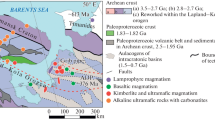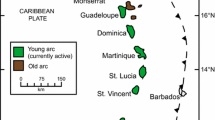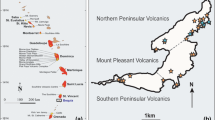Abstract
Patches of glass with a second generation of small crystals of olivine, clinopyroxene, and spinel are abundant in hydrous peridotite mantle xenoliths with tabular equigranular textures from two maar-type volcanoes, Meerfelder Maar and Dreiser Weiher (West Eifel, Germany). The patches are similar in size to the main phases of the hosting peridotite. Their central part is often occupied by relics of pargasitic amphibole. Mass-balance calculations show that the patches were formed by surface controlled incongruent thermal breakdown of amphibole according to the reaction: amphibole ↔ olivine + clinopyroxene + spinel + melt. Simultaneously with the decomposition of amphibole, small crystals of olivine, clinopyroxene, and spinel grew radially from the patch/peridotite interface toward the centre of the patch. Apart from sector zoning of clinopyroxene, the crystals are virtually homogeneous and are separated from the amphibole by a seam of melt (glass). Secondary olivines reveal higher Mg-numbers, secondary clinopyroxenes higher Cr2O3 concentrations than olivines and clinopyroxenes, respectively, of the host peridotite. The silica contents of melts produced by the above breakdown reaction range from 48 to 52% SiO2 as a function of the composition of the parent amphiboles. Patches surrounded by primary olivines only reveal no reaction with the host peridotite. The variation of SiO2, MgO and CaO in melts from these patches is the result of minor precipitation of olivine and clinopyroxene during fast cooling. If patches are in contact with primary olivine and orthopyroxene, melts are additionally modified by the reaction liquid 1 + orthopyroxene ↔ liquid 2 + olivine + clinopyroxene resulting in more silica-rich compositions between 54 and 58%. For the rare glasses richer in silica, a more complex formation is required. Veinlets along grain boundaries are filled with glasses which are chemically identical to those from nearby patches. This suggests that the veinlets were filled by melts formed by amphibole breakdown during entrainment of the xenoliths to the host magmas.






Similar content being viewed by others
References
Brey G, Köhler T (1990) Geobarometry in four phase lherzolites II. New thermobarometers, and practical assessment of existing thermobarometers. J Petrol 31:1353–1378
Edgar AD, Lloyd FE, Forsyth DM, Barnett RI (1989) Origin of glass in upper mantle xenoliths from the Quaternary volcanics of Gees, West Germany. Contrib Mineral Petrol 103:277–286
Franz L, Wirth R (1997) Thin intergranular melt films and melt pockets in spinel peridotite xenoliths from the Rhön area (Germany): early stage of melt generation by grain boundary melting. Contrib Mineral Petrol 129:268–283
Klügel A (1998) Reactions between mantle xenoliths and host magma beneath La Palma (Canary Islands): constraints on magma ascent rates and crustal reservoirs. Contrib Mineral Petrol 131:237–257
Köhler T, Brey G (1990) Calcium exchange between olivine and clinopyroxene calibrated as a geothermometer for natural peridotites from 2 to 60 kb with applications. Geochim Cosmochim Acta 54:2375–2388
Maaløe S, Printzlau I (1979) Natural partial melting of spinel lherzolite. J Petrol 20:727–741
Mertes H, Schmincke HU (1985) Mafic potassic lavas of the Quaternary West Eifel volcanic field. Contrib Mineral Petrol 89:330–345
Neumann ER, Wulff-Pedersen E (1997) The origin of highly silicic glass in mantle xenoliths from the Canary Islands. J Petrol 38:1513–1539
O’Connor TK, Edgar AD, Lloyd FE (1996) Origin of glass in Quaternary mantle xenoliths from Meerfelder Maar, West Eifel, Germany: implications for enrichment in the lithospheric mantle. Can Mineral 34:187–200
Sachtleben TH (1980) Petrologie ultrabasischer Auswürflinge aus der Westeifel. Dissertation, Köln
Schiano P, Clocchiatti R (1994) Worldwide occurrence of silica-rich melts in sub-continental and sub-oceanic mantle minerals. Nature 368:621–624
Shaw CSJ (1999) Dissolution of orthopyroxene in basanitic magma between 0.4 and 2 GPa: further implications for the origin of Si-rich alkaline glass inclusions in mantle xenoliths. Contrib Mineral Petrol 135:114–132
Shaw CSJ, Klügel A (2002) The pressure and temperature conditions and timing of glass formation in mantle-derived xenoliths from Baarley, West Eifel, Germany: the case for amphibole breakdown, lava infiltration and mineral-melt reaction. Mineral Petrol 74:163–187
Shaw CSJ, Thibault Y, Edgar AD, Lloyd FE (1998) Mechanisms of orthopyroxene dissolution in silica-undersatuated melts at 1 atmosphere and implications for the origin of silica-rich glass in mantle xenoliths. Contrib Mineral Petrol 132:354–370
Stosch HG (1987) Constitution and evolution of subcontinental upper mantle and lower crust in areas of young volcanism: trace element and Sr and Nd isotopic geochemistry of peridotite xenoliths from the Eifel (West Germany) and their bearing on the evolution of the subcontinental lithosphere. Fortschr Miner 65:49–86
Stosch HG, Seck HA (1980) Geochemistry and mineralogy of two spinel peridotite suites from the Dreiser Weiher, West Germany. Geochim Cosmochim Acta 44:457–470
Wallace X, Green HD (1991) Stability of mantle amphibole. Mineral Petrol 44:1–9
Wilshire HG, McGuire AV (1996) Magmatic infiltration and melting in the lower crust and upper mantle beneath the Cima volcanic field, California. Contrib Mineral Petrol 123:358–374
Witt-Eickschen G, Seck HA, Reys C (1993) Multiple enrichment processes and their relationships in the subcontinental lithosphere beneath the Eifel (Germany). J Petrol 34:1-22
Witt-Eickschen G, Harte B (1994) Distribution of trace elements between amphibole and clinopyroxene from mantle peridotites of the Eifel (western Germany): An ion-microprobe study. Chem Geol 117:235–250
Witt-Eickschen G, Kramm U (1998) Evidence for the multiple stage evolution of the subcontinental lithospheric mantle beneath the Eifel (Germany) from pyroxenite and composite pyroxenite / peridotite xenoliths. Contrib Mineral Petrol 131:258-272
Witt-Eickschen G, Klemd R, Seck HA (2003) Density contrast of fluid inclusions associated with melt (glass) from two distinct suites of mantle peridotites from the West Eifel, Germany: implications for melt origin. Eur J Mineral 15:95–102
Wulff-Pedersen E, Neumann ER, Vannuci R, Bottazzi P, Ottolini L (1999) Silicic melts produced by reaction between peridotite and infiltrating basaltic melts: ion probe data on glasses and minerals in veined xenoliths from La Palma, Canary Islands. Contrib Mineral Petrol 137:59–82
Zinngrebe E, Foley SF (1995) Metasomatism in mantle xenoliths from Gees, West Eifel, Germany: evidence for the genesis of calc-alkaline glasses and metasomatic Ca-enrichment. Contrib Mineral Petrol 122:79–96
Acknowledgements
Constructive reviews of an earlier more extended manuscript by St. Foley and Cl. Shaw are gratefully acknowledged.
Author information
Authors and Affiliations
Corresponding author
Rights and permissions
About this article
Cite this article
Ban, M., Witt-Eickschen, G., Klein, M. et al. The origin of glasses in hydrous mantle xenoliths from the West Eifel, Germany: incongruent break down of amphibole. Contrib Mineral Petrol 148, 511–523 (2005). https://doi.org/10.1007/s00410-004-0623-x
Received:
Accepted:
Published:
Issue Date:
DOI: https://doi.org/10.1007/s00410-004-0623-x




